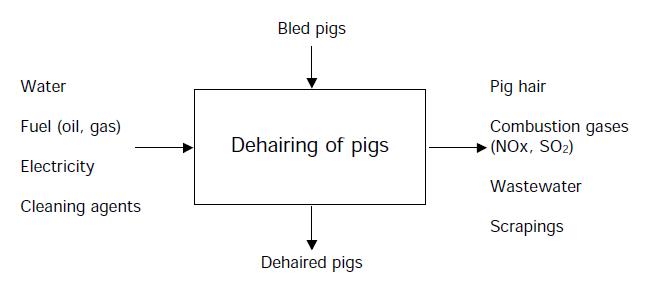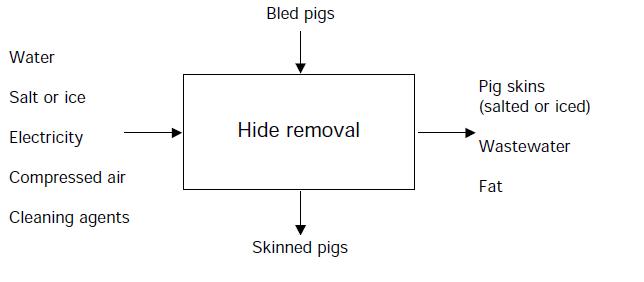Additional information: Hide treatment of pigs
1. Description of techniques, methods and equipment
The objective of surface treatment is to remove dirt and hair from pig carcasses before further processing. Carcasses are scaled with water (~60 °C) in a scald tank or in scalding cabinets for making the skin softer for the following hair removal. Alkaline reagents for removing the layer of accumulated oil, dirt and epidermal cells from the skin surface are often added to the water, because they make the skin become whiter. The next step is to remove hair by manual shaving or in a de-hairing machine. Any remaining hair is then singed with a gas fired torch manually or by passing the skin through a singeing oven following by flushing with cold water. Any discolouration is removed by manual scraping or in a scraping machine. The surface is cleaned by showering and brushing, the skin is loosened and pulled of. Fat is removed and the skins are immediately salted or iced and are later sold for tanning.
- Flow diagrams
Figure 1: Inputs and Outputs for dehairing of pigs
Figure 2: Inputs and Outputs for skinning of pigs
2. New technologies
- a) Changes in the process
No information is available.
- b) Changes in the energy distribution system
A number of strategies are developed for reducing energy demand for this kind of process.
- Scalding tanks should be insulated and covered by a lid to avoid heat and evaporation losses. It helps to save energy and water.
- Scalding tanks also should have a steep gradient towards the outlet at the bottom to reduce their water consumption in general.
- Wastewater should pass trough a sedimentation tank, an interceptor trap and a sand trap before it is discharged. This step requires high investment costs.
- There is the possibility of water reuse. Cooling water can be collected in tanks and can later be reused for water sprays in de-hairing machines or the boiler condensate can be used as make-up water for scalding tanks.
- Automatically operated scalding chambers use less water than manual operated ones und the reduction of water consumption can be up to 70%, but also in this part we have high investment costs.
- Strainer could be fitted to floor drain outlets to collect hair from the de-hairing process.
- Also singeing ovens should be insulated and automatic doors which close during singeing cause energy savings. The gas consumption is reduced by solenoid switches which make the singeing flame just initiating when carcasses pass trough the oven.
- Overhead rails in oven are often cooled by using cold water. If not to use more water as necessary thermometers should be installed to measure temperatures. So the flow can be regulated to the minimum required.
- c) Changes in heat supply
No information is available.
Source: Cleaner Production Assessment in Meat Processing; prepared by COWI Denmark for UNEP (United States Environment Programs) and Danish Environmental Protection Agency, 2000 Denmark

